
young male

mature male and female

young male

mature female
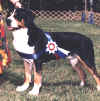
mature male

mature male

10 yr old male

9 yr old male

mature female
UNDER CONSTRUCTION: THIS PAGE will take some time for me to finish--More pics will load in a few days, Last updated 11/20/97
Type, Structure & Movement
All dogs used in this Pictorial display are dogs I own(ed) myself (in whole or in part) or dogs whose owners have graciously given their permission for me to openly and publicly critique their dogs. Anyone wishing to have their dog shown here please email me or snail mail any pictures/descriptions that you would like to see here. Examples of good traits are as welcome as examples of poor traits, especially front and side views of nice heads and photos of correct and incorrect movement (which is difficult to photograph) so look through your photos. The quoted portions from the AKC Standard for GSMD are printed in bold color, all of my own descriptions and opinions are in standard black type.
DISCLAIMER: This Illustrated Standard and Comments section is MY OPINION, based on my experience, knowledge of and ongoing study of this breed and the historical information available about GSMD. My comments are not supported nor endorsed by any club, officer, nor individual other than MYSELF. If you disagree with any or ALL of my comments or descriptions per photographs, feel free to let me know but don't necessarily assume I will change my opinion regardless of the argument (GRIN).
General Appearance: The Greater Swiss Mountain Dog is a draft breed and should structurally appear as such. It is a striking, tri-colored, large, powerful dog of sturdy appearance.
Type = Essence. Type is how I describe a dog that just is built to work. When I think of the Perfect GSMD or the "essence" of the perfect GSMD it is all tied up in the overall picture of a solid, sturdily built dog which has an air of confidence and a pleasant expression. A dog that can and will enjoy working all day long pulling a cart or hiking with an Alpine herdsman moving the flocks from pasture to pasture in the Swiss Alps. I picture a Large, Robust, Animated and Friendly looking and acting dog. A dog that can play like a goofball, but still get down to business with a cart and harness on, pulling for his partner/leader. A dog that when the work is done, will quietly rest at your feet or sack out nearby with the family.
Here are a few overall shots of dogs I look at and see what I consider solid "type" (I will pick apart their and other dog's conformational strengths and weaknesses later). Look at the overall dog first and see the "essence" that I am trying to describe.
 young male |
 mature male and female |
 young male |
 mature female |
 mature male |
 mature male |
 10 yr old male |
 9 yr old male |
 mature female |
Size, Proportion, and Substance: Height at the highest point on the shoulder is ideally: Dogs: 25.5 to 28.5 inches Bitches: 23.5 to 27 inches Body length to height is a 10 to 9 proportion. The body is full.
This is a recommendation for size, not a disqualification, proportion should be more important than sheer size/height.
TYPE:
Type is often confused with the look of the head. Many newcomers to our breed (or any other) are capable of looking at and distinguishing among different head types and depending upon who they listen to, they will tell you which dog is "typey" by the look of the head. The head in my opinion is just part of what you need to look at to describe type, it is an integral part, but not the only part. For I have seen dogs described by neophytes and even some judges as "dripping" in type when they had a really exaggerated and obvious head - but not necessarily a "correct" head. . Unfortunately, some of the nicest heads are on occassion attached to really poor bodies, weak structure or worse yet possessed by dogs with horrible temperaments--In which case I believe it is FRAUD to call those specimens "Typey". That said, let's look at heads.....
HEAD and Expression
The standard says: "Expression is animated and gentle. The eyes are dark brown, medium sized, neither deep set nor prominent with close fitting eyelids. Eye rims are black. The ears are medium sized, set high, triangular in shape, gently rounded at the tip, and hang close to the head when in repose."
You should get the idea that these dogs are friendly and gentle, they should not look "hard" nor "mean". They are very alert, but not aggressively so. They are quick to give voice to announce changes in the environment and for that they are good "watch" dogs, I do not find them to be good "guard" dogs, there is a difference!!!
"When alert, the ears are brought forward and raised at the base. The top of the ear is level with the top of the skull. The skull is flat and broad with a slight stop.
Alert correct head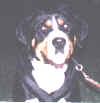 |
|
Overdone "fleshy" head, Fault | Rounded head fault |
snipey insert |
"The skull and muzzle are of equal length. The muzzle is blunt, not pointed. The muzzle is also strong and straight." The standard also USED to say that the there was a slight rise toward the end of the muzzle to describe the mastiff-like seismoid bone that is so obvious in the older (in my opinion correct) dogs, unfortunately the standard was rewritten to be less descriptive/more lenient and in so doing leads new people and judges to the breed to believe that a dog with a strong muzzle is somehow "incorrect" because the standard makes no mention of this trait. This is where it is important to study historical photographs and standards and descriptions to make sure you are not mistaking what really is correct for a fault.
strong muzzle, nice head  |
muzzle too short, fault 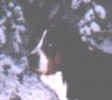 |
Ignore the flopped over ear and see the Stong cheeks and muzzle, correct
but still "bloodhoundy" looking bitch overall |
for a male slightly snipey/pointed muzzle fault, weak cheekbones 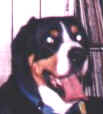 |
"The nose is always black".
Pic to follow-- not scanned yet, Swissy puppies are born with pink noses and pink feet, both of which will turn black by the time the dog is mature. Judges and exhibitors need to realize that faulting a dog for pink marks still on the nose is ridiculous from the puppy classes. Most dogs' noses have filled in by the time they are 18 months old, and certainly will fill in by maturity at 2-3 years. I have NEVER seen an adult with pink on his/her nose but I have seen many many dogs with lingering pink well into their first year. Don't let anyone convince you your dog is not show quality because of that lack of pigment when young, don't let judges continue to believe it either and for gosh sakes don't let handlers convince you to tattoo or otherwise fraudulently and illegally alter your dog's pigment.
"The lips are clean and as a dry-mouthed breed, flews are only slightly developed."
Good "dry" clean lips/flews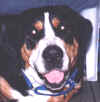 |
Over developed lips/flews/dewlap 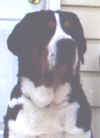 |
" The teeth meet in a scissor bite. "
The old standard also said "all teeth present", I consider it a serious fault to have missing teeth, but our standard does not mention the number of teeth at all, it is unwise to ignore missing or poor teeth, for if we start to ignore it, we will be plagued with problems later.
Also remember that many puppies at 2-5 months will be slightly overshot, it is my experience that those puppies and those that Go overshot at 5-6 months while teething will self correct. Try to avoid pulling any baby teeth because pulling these teeth can cause the jaw to grow in a spurt and thereby making the bite worse in the long run. Let them teethe as normal and leave the mouth alone. Obviously, if deciduous teeth are still in the mouth after 6-7 months they should be removed-try to combine that procedure with the neuter/spay surgery if possible to only use anesthesia one time.
The converse is also true that puppies with tight tight scissors as little babies will often go level or undershot as they mature. Also dogs whose baby teeth are removed because they go overshot at 5 months almost always go undershot or level as adults. Better to try to leave them alone so you don't accidently screw up the bite by interfering. Personally, I will always take the chance on a slightly overshot puppy than on one that is tightly scissor as an 8-10 week old. A puppy with a significant overbite (more than 1/4 inch) will not self correct.
Neck, Topline, and Body
"The neck is of moderate length, strong, muscular and clean."
"The topline is level from the withers to the croup"
 good level
topline, also good neck and strong rear angulation good level
topline, also good neck and strong rear angulation |
weak topline - "swayback", good rear and strong front, pleasant
head for a bitch |
"The chest is deep and broad with a slight protruding breast bone."
Withers are high and long. Body is full with a slight tuck-up. Ribs are well sprung. The loins are broad and strong. The croup is long, broad and smoothly rounded to the tail insertion."
A full body does not mean a fat one. TOO many dogs are shown and kept in obese condition, it is unhealthy and it will shorten their lives. Do not let fat be mistaken for "substance". The dog should not "roll" from side to side when gaiting.
 fat dog and fat me, this is a great dog,
but kept with entirely too much weight for his health. Fat is not healthy for dogs
or people, I know!!! fat dog and fat me, this is a great dog,
but kept with entirely too much weight for his health. Fat is not healthy for dogs
or people, I know!!! |
"The tail is fairly level reaching to the hocks, carried down in repose and raised when excited. The bones of the tail should be straight."
This also was changed from the original standard and differs from the FCI standard. The old standard and the FCI standard both agreed and said something to the effect of ".... carried down in repose and slightly elevated when excited, NEVER curled or carried over the back". A kinked tail was considered reason to require that a puppy be sold as pet quality with a neuter contract. I still do this, but many show/breeding animals have kinks in the tail and/or their tails curl up and are carried over the back of the dog. I was told by oldtimers in this breed that a kink in the tail is not something you want to breed because if you double up on it, you may well produce puppies whose vertebrae "kink" higher up in the spine and that would be disastrous.
I don't take the chance and I don't like a "gay" tail carried over the back, I find it takes away from the continuous look of the topline and gives the dog a "square" look rather than the correct 9 to 10 ratio.
| use peach tail for a fuzzy one | use gay tails |
(use pic of gr with kink in tail and r pup with kink at food bowl. ) Another pic of adult dog with kink pending.
| Kinked tail on the puppy top left, all other tails are straight and normal |  |
"Forequarters: The shoulders are long, sloping and strong. They are flat and well muscled. Forelegs are straight and strong. The pasterns slope very slightly, but are never weak. The feet are round and compact with well arched toes. The dew claws may or may not be present.
Now, it is important to remember that dogs should "move" with straight front movement-- their feet should land generally facing forward. However, dogs that stop dead into a perfect stack -- feet facing "exactly" forward are often slightly Pidgeon toe'd (toe in) when moving, a well-built dog actually stops slightly (VERY SLIGHTLY) east-west but he moves true with straight forward pointing toes, not toes that point out nor in, nor pasterns (wrists) that flop about while moving.
Young dogs are often more than slightly East/west in the front, they often look like they have both front legs coming out of the same hole in their chest. Swissies grow with strange leaps and bounds, don't be surprised to find your beautiful puppy looking like a hideous 9 month old gangly, dorky adolescent, with knobby joints and no one leg facing the same direction.
Many new people or egotistical overnight "experts" to this breed will "bail" on a good dog, or criticize one that was perfect as a puppy, but fell apart at 9 months. Don't listen to them---Trust what the pedigree has to offer, trust how they looked at 8-9 weeks old and WAIT for them to mature, with some dogs they may need 3+ years to look like the real thing. You don't need to show them ugly, just don't give up on them until they come back together--look to the parents and grandparents of your puppy -- if they are ugly adults, you won't get anywhere waiting, but if they are beautiful then have patience with your "ugly duckling".
I prefer to have dogs that go "ugly" at adolescence and then BLOOM as adults, than those that are PERFECT nine month olds who get worse and unsound as they mature. Another good reason to wait to breed until dogs are two years old or better, breeding before that age is a risk as you don't know what you have YET -- so why are you passing it on, aside from the fact that it is unethical to breed without OFA numbers, etc.
"Hindquarters: The thighs are broad, strong
and muscular. The stifles are moderately bent and taper smoothly into the hocks. The hocks
are well let down and straight when viewed from the rear. Dew claws must be removed. Feet
are compact and turn neither in or out."
I have been very lucky to have good rears to start with and have (still lucky) perpetuated them through my puppies and thankfully I have no pictures of poor rears, if anyone has some to share, please send them and I will cut the front of the dog from the photo so that the identity is not known. (notice I didn't (couldn't) say this when describing fronts:) GRIN)
Also, puppies often appear "hocky", i.e their rear feet point outwards and their hocks seem to almost want to touch when they are just hanging out standing around. Don't let that alarm you unless the pedigree shows you dogs with weak rears and who stand "hocky" as adults. More GSMD who are weak in the rear are "straight" in the stifle with weak overextending hocks rather than too angulated and "hocky".
When choosing puppies in a litter I will always take the chance on a puppy who is a little hocky at 8 weeks over one that stands perfect at that age-- my experience is that the perfect rear at 8 weeks will be a straight stifle at maturity. Also try to pick a puppy who is balanced, if the rear is VERY angulated the front must be as well-- same with a dog with moderate angulation, etc. My experience is limited to the pedigrees I know very well, some of the strongly angulated Swedish GSMD are outside of my experience and I don't know how they looked as puppies. I don't think I would pick a "hocky" puppy from a litter out of some of the Swedish descendants, but I still would not pick a straight reared puppy either.
It is also a good idea to feel the strength of the hocks in a litter of young puppies, when they are standing naturally, gently press forward with one finger at the point of the hock, if there is ANY "give" whatsoever beware of future weakness in that joint. The hocks should be strong and no "over"-extension should be seen. The hocks are more likely to cause an older GSMD pain from arthritis than his hips are. I check for that same weakness when looking at a dog I would breed to.
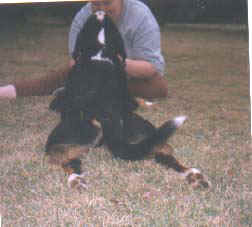
Many many Swissies stretch out comfortably with their back legs kicked out behind them, we call it "frog dog". I have seen them sleep like this, play like this, I have several that roll on their backs and keep the position. I have also heard people say that it is a "sure sign of dysplasia" or that if they can do this then they "can't be dysplastic". Well I have dogs who are and who aren't dysplastic and there doesn't seem to be any difference in how they "frog" to me. Those who are comfortable in that position do it, those who aren't, don't. The ONLY way you can know if your dog is dyplastic is to xray him and send the films to the OFA for evaluation. No other physical or behavioral characteristic is diagnostic, it is just wishful thinking or worried paranoia. Xray to know for sure and don't breed on old-wives tales:)
"Coat: The top coat is dense, 1 to 1 and 3/4
inches long. The undercoat
may be thick and sometimes showing."
Well this is another of those places the standard was changed. It used to say "the undercoat IS thick and sometimes showing" and the FCI standard goes into great detail of the serious FAULT that "lack of undercoat" is. Both are a far cry from "undercoat MAY be thick....." That leads judges and exhibitors to think that maybe it is okay to not have an undercoat. I have seen quite a few dogs lacking undercoat being shown and sure they are strikingly clean looking compared to a dog with a yellowish or light grey showing undercoat, but correct is correct. I would not want to see either taken completely out of the gene pool for either extreme as it is simply cosmetic in nature, still I would prefer more judges familiarize themselves with what is CORRECT so that they don't fault correct and frumpy over pretty and incorrect in the ring.
This is difficult to illustrate but maybe these are sharp enough to see the difference
| Good coat, thick undercoat but it is dark grey and not visible, the best type of coat |
 Sleek,
lacking undercoat Sleek,
lacking undercoat |
showing undercoat
|
"Color: The ground color is jet black. The
markings are rich rust and white. Symmetry of markings is desired. Rust appears
over each eye, on each cheek, on each side of the chest, on all four legs, and under the
tail. There is a white blaze and muzzle. A white marking on the chest typically forms and
inverted cross. The tip of the tail is white, and white is present on the feet with rust
between the white and black on each leg. White patches or a collar is permitted around the
neck.
Color is the least important of all the attributes of a GSMD. They are all tri-colored dogs to what degree is a matter of taste. Symetry can be from very bright to very dark. Remember that color rarely breeds true, dark to dark may well produce wildly marked puppies and viceversa. Remember that color is COSMETIC and has nothing to do with how the dog works, his temperament, his structure or soundness. Judges, exhibitors and breeders need to beware of putting a premium on markings -- it will the the downfall of our breed if the "instant expert" so-called breeders continue to cull for markings. Even a child can see the differences in markings but it takes experience and guts to breed for the dog "under the fur" and not to only try for simple cosmetic attributes, but always for the overall GSMD. Below see some different but still acceptable markings:
"Gait: Good reach in front, powerful drive in rear. Movement with a level
back."
"Temperament: Bold, faithful, willing worker.
Alert and vigilant. Nervousness or
aggressiveness should be severely penalized."
THIS IS THE ONE AND ONLY MENTION IN THE STANDARD OF SOMETHING THAT SHOULD BE
"SEVERELY PENALIZED" JUDGES TAKE HEED, EXHIBITORS AND BREEDERS, THIS IS THE MOST
IMPORTANT TRAIT OF A GSMD, ABOVE ALL ELSE HE IS A GOOD DOG WHO IS NOT A SPOOK AND NOT
EASILY AGITATED!!!!!
The most beautiful dog in the world is WORTHLESS without a good
temperament, it is not something you can correct "in the next generation" it is
not something you can overlook. This is a big gentle, docile, confident
breed-- PLEASE try to keep them that way.
"Disqualifications: Any ground color other than
black. Blue eye color."
I am looking for pics of these attributes, I will add them when I get some.
more to follow -- work in progress Please check in often!!! ....puppies....litters....choosing to keep, choosing to breed, etc.